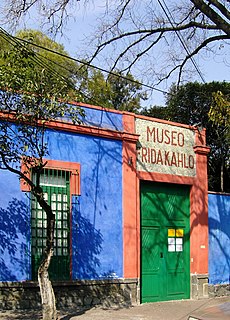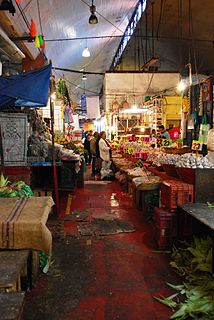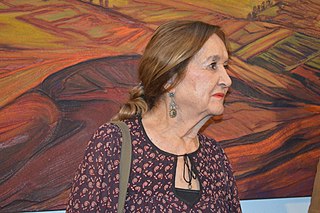
Diego María de la Concepción Juan Nepomuceno Estanislao de la Rivera y Barrientos Acosta y Rodríguez, known as Diego Rivera, was a prominent Mexican painter. His large frescoes helped establish the mural movement in Mexican and international art.

The Palacio de Bellas Artes is a prominent cultural center in Mexico City. It has hosted notable events in music, dance, theatre, opera and literature in Mexico and has held important exhibitions of painting, sculpture and photography. Consequently, the Palacio de Bellas Artes has been called the "Cathedral of Art in Mexico". The building is located on the western side of the historic center of Mexico City next to the Alameda Central park.

Arnold Belkin was a Canadian-Mexican painter credited for continuing the Mexican muralism tradition at a time when many Mexican painters were shifting away from it. Born and raised in western Canada, he trained as an artist there but was not drawn to traditional Canadian art. Instead he was inspired by images of Diego Rivera's work in a magazine to move to Mexico when he was only eighteen. He studied further in Mexico, focusing his education and his career mostly on murals, creating a type of work he called a "portable mural" as a way to adapt it to new architectural style. He also had a successful career creating canvas works as well with several notable series of paintings. He spent most of his life and career in Mexico except for a stay in New York City in the late 1960s to mid-1970s. His best known works are the murals he created for the University Autónoma Metropolitana in the Iztapalapa borough of Mexico City.

A tianguis is an open-air market or bazaar that is traditionally held on certain market days in a town or city neighborhood in Mexico and Central America. This bazaar tradition has its roots well into the pre-Hispanic period and continues in many cases essentially unchanged into the present day. The word tianguis comes from tiyānquiztli in Classical Nahuatl, the language of the Aztec Empire. In rural areas, many traditional types of merchandise are still sold, such as agriculture supplies and products as well as modern, mass-produced goods. In the cities, mass-produced goods are mostly sold, but the organization of tianguis events is mostly the same. There are also specialty tianguis events for holidays such as Christmas as well as for particular types of items such as cars or art.

José Chávez Morado was a Mexican artist who was associated with the Mexican muralism movement of the 20th century. His generation followed that of Diego Rivera, José Clemente Orozco and David Alfaro Siqueiros. Although Chávez Morado took classes in California and Mexico, he is considered to be mostly self-taught. He experimented with various materials, and was an early user of Italian mosaic in monumental works. His major works include murals at the Ciudad Universitaria, Secretaría de Comunicaciones y Transportes and Museo Nacional de Antropología in Mexico City as well as frescos at the Alhóndiga de Granaditas, which took twelve years to paint. From the 1940s on, he also worked as a cultural promoter, establishing a number of cultural institutions especially in his home state of Guanajuato including the Museo de Arte Olga Costa - José Chávez Morado, named after himself and his wife, artist Olga Costa.

Jorge González Camarena was a Mexican prominent painter, muralist and sculptor. He is best known for his mural work, as part of the Mexican muralism movement, although his work is distinct from the main names associated with it. His major works include the mural on the main administration building of the Monterrey Institute of Technology and Higher Studies and a mural created for the Universidad de Concepción in Chile. He also created easel works, one of which, La Patria, was well known in Mexico as it was used on the cover of free textbooks from the 1960s into the 1970s. Recognitions for his work include the Premio Nacional de Arte, membership in the Academia de Artes and the Ordine al Merito della Repubblica Italiana, grade Commendatore from the Italian government.
"Abel" Antonio Pujol Jiménez was a Mexican painter and printmaker.

Manuel Rodríguez Lozano was a Mexican painter, known for his “melancholy” depiction of Mexico rather than the more dominant political or festive one of the Mexican muralism movement. This is especially true of his “white stage” which is marked by cold colors and tragic scenes focusing on human figures which are skeletal or ghost-like. His work influenced Mexican films such as La perla.
Pablo Esteban O'Higgins was an American-Mexican artist, muralist and illustrator.

The Frida Kahlo Museum, also known as the Blue House for the structure's cobalt-blue walls, is a historic house museum and art museum dedicated to the life and work of Mexican artist Frida Kahlo. It is located in the Colonia del Carmen neighborhood of Coyoacán in Mexico City. The building was Kahlo's birthplace, the home where she grew up, lived with her husband Diego Rivera for a number of years, and where she later died in a room on the upper floor. In 1957, Diego Rivera donated the home and its contents in order to turn it into a museum in Frida's honor.

Traditional fixed markets in Mexico are multiple-vendor markets permanently housed in a fixed location. They go by a variety of names such as "mercados públicos", "mercados municipales" or even more often simply "mercados" (markets). These markets are distinct from others in that they are almost always housed in buildings owned and operated by the local government, with numerous stands inside rented by individual merchants, who usually sell produce and other basic food staples. This market developed in Mexico as a way to regulate pre Hispanic markets called tianguis. These tianguis markets remain in Mexico, with the most traditional held on certain days, put up and taken down the same day, much the way it was done in Mesoamerica.
Ángel Bracho was a Mexican engraver and painter who is best known for his politically themed work associated with the Taller de Gráfica Popular; however he painted a number of notable murals as well. Bracho was from a lower-class family and worked a number of menial jobs before taking night classes for workers at the Escuela Nacional de Artes Plásticas. Even though he had only four years of primary school, he then studied as a full-time student at the university. His art career began working with Diego Rivera on the painting of the Abelardo L. Rodríguez market in Mexico City. He was a founding member of the Taller de Gráfica Popular, making posters that would become characteristic of the group. His graphic design work is simple, clean and fine dealing with themes related to social struggles with farm workers, laborers and Mexican landscapes.
Desiderio Hernández Xochitiotzin was a Mexican artist best known for his large-scale mural work inside the State Government Palace in the state of Tlaxcala, Mexico, the last large scale mural of the Mexican muralism movement.
Abelardo Ávila Villareal was a Mexican engraver noted for his Costumbrista work, mostly with the Sociedad Mexicana de Grabadores; however, he did paint one mural along with Pedro Rendón at the Abelardo L. Rodríguez market in Mexico City.

Xavier Guerrero was one of the pioneers of the Mexican muralism movement in the early 20th century. He learned painting working with his father, who worked in masonry and decorating, with evidence that his ability was mostly self-taught. In 1912, he moved to Guadalajara and began painting murals, moving to Mexico City in 1919 just as the muralism movement was about to begin. Most of his work was in collaboration with or subordinate to other painters such as Diego Rivera and David Alfaro Siqueiros, working at the San Ildefonso College, the Secretaría de Educación Pública building and the Universidad Autónoma de Chapingo; however, much of his other work has been lost. While best known for his mural work, his later canvas work is considered to be better.

Rina Lazo Wasem was a Guatemalan-Mexican painter. She began her career in mural painting with Diego Rivera as his assistant. She worked with him from 1947 until his death in 1957 on projects both in Mexico and Guatemala. Thereafter, she remained an active painter, better known for her mural works than canvases, although the latter have been exhibited in Mexico and other countries. This has made her one of Guatemala's best-known artists. She was a member of the Mexican muralism movement and criticized modern artists as too commercial and not committed to social causes. She believed muralism would revive in Mexico because of its historical value.
Francisco Icaza was a Mexican artist best known for his drawings about his travels and his oil paintings. He spent much of his life living in and visiting various countries around the world. He began painting as a child while living as a refugee in the Mexican embassy in Germany. Icaza exhibited his work both in Mexico and abroad in Europe, South America, the Middle East, Asia and India, most notably at his three major solo exhibitions at the Museo de Arte Moderno in Mexico City. He also painted a mural dedicated to Bertolt Brecht, La Farándula, at the Casino de la Selva in Cuernavaca, a focus of controversy when the work was moved and restored in the early 2000s. He painted additional murals for the Mexican Pavilion at the HemisFair in Texas ; for the Mexican Pavilion at Expo 67 in Montreal, Canada ; and for the Mexican Pavilion in Osaka at Expo '70. This last mural is held at the Museo de Arte Abstracto Manuel Felguérez in Zacatecas City. He was an active member of the Salón de la Plástica Mexicana and also a member and founder of several important Mexican artistic movements including Los Interioristas, El Salón Independiente, and La Confrontación 66.
Benito Messeguer was a Mexican artist born in Spain best known for his murals, which continued much of the work of the Mexican muralism movement. His work was recognized with a tribute at the Palacio de Bellas Artes shortly before his death and membership in the Salón de la Plástica Mexicana.

Ponce Servicos, formerly Plaza del Mercado Juan Bigas, is a brutalist municipal building located Ponce, Puerto Rico. It is the largest building in the municipality in terms of footprint area and the only one that occupies an entire city block. The structure was built in 1981 as a way to provide a modern, air-conditioned, structure for the merchants and shoppers of the historic but aging Plaza de Mercado Isabel II building, while the latter underwent restoration. On its opening day it was named Plaza del Mercado Juan Bigas, in honor of Juan Bigas Moulins, the Ponce businessman by that name.
















